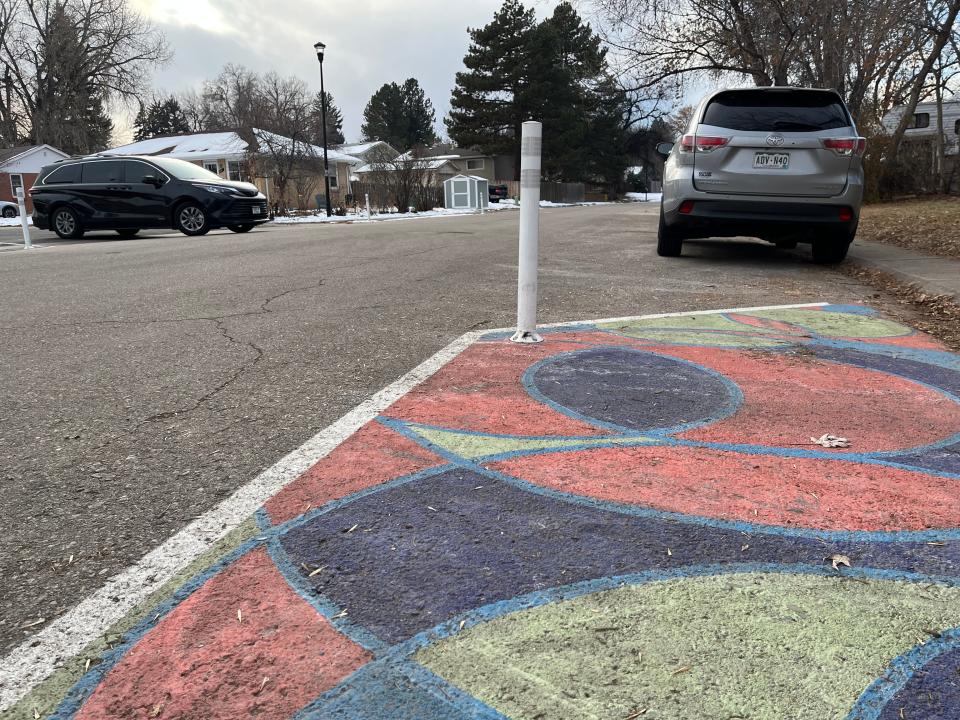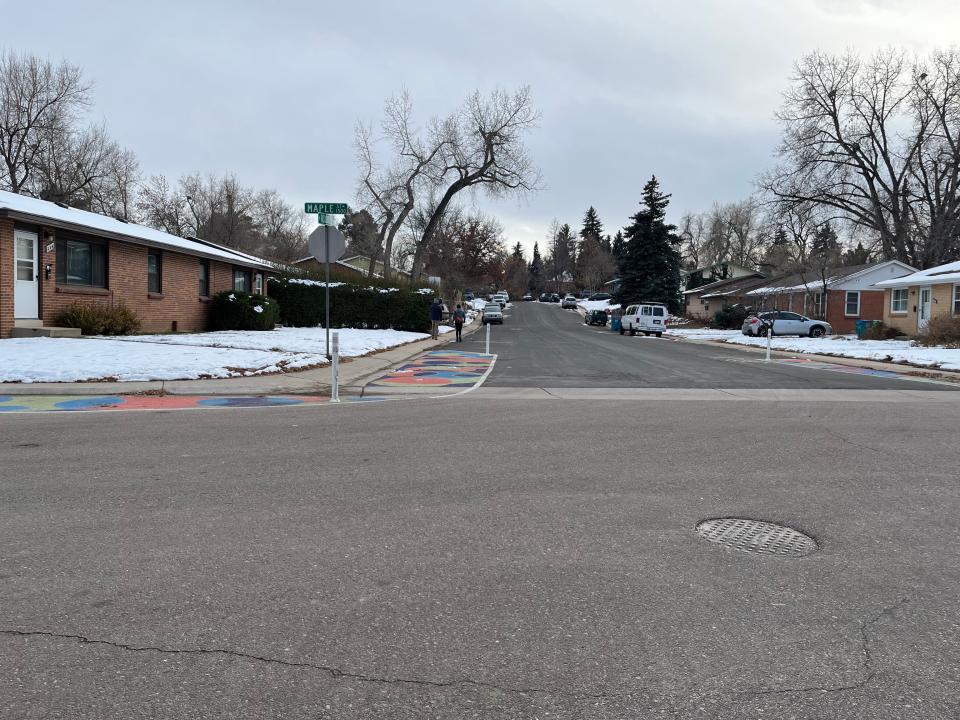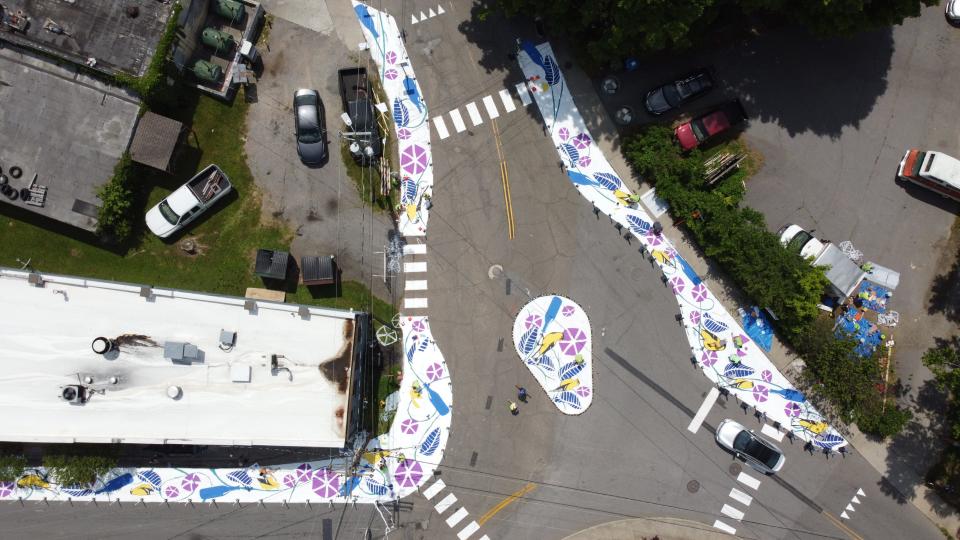A confusing 3-way Fort Collins intersection is getting a makeover, using art
Fort Collins has received a $25,000 grant to help make a confusing intersection safer for pedestrians by using asphalt art.
A Bloomberg Philanthropies grant will fund an asphalt art project at the intersection of three streets near The Lincoln Center: Magnolia Street, Canyon Avenue and Sherwood Street.
The idea is to create a traffic circle and add curb extensions using paint, which will cue drivers to slow down and yield to pedestrians, according to the city and Bloomberg.
The Magnolia-Canyon-Sherwood intersection was identified a few years ago as a candidate for the use of painted infrastructure, but city engineers weren't yet ready to take that step, said Anna Kelso, the city's Active Modes specialist.
Currently the intersection uses stop signs, and there's a lot of confusion about right-of-way, she said.
Using paint and posts, the project will provide a visual cue for drivers that pedestrians or cyclists are in the area, Kelso said.
The design is meant to slow traffic by creating a narrower path for vehicles. And with painted areas serving as curb extensions past parked cars, it improves visibility and shortens the pedestrian crossing, Kelso said.
The city has already installed asphalt art at a few locations, mostly mid-block locations where there isn't a high level of traffic, to beautify, create community engagement and calm traffic.
Projects have been installed on four roadways in Fort Collins, including in the Andersonville, Alta Vista and Hickory Village Mobile Home Park neighborhoods.
Those murals are beautiful and have humanized the streets by creating a more welcoming environment, Kelso said. But with the paint in the path of vehicles, they can be fairly short-lived and are not necessarily the highest and best use of what can be done with asphalt art.
Another project, at Maple Street and Roosevelt Avenue, goes farther as infrastructure. Paint extends the pedestrian area past parked cars, and white posts provide another visual boundary.

It's so "Fort Collins," said Kim Donegan, who has lived in the neighborhood for 15 years.
At first, a colorful mural was painted to cover the entire roadway, where Roosevelt Avenue zags through Maple Street, just down the street from Putnam Elementary.
Donegan's daughter helped paint it, as part of the asphalt art program's community participation aspect, where residents are invited to come out and "paint by numbers" under the guidance of the artist.
But last year, the city modified the design, installing white pylons and using paint only on the extended curb area.

Now it's also more helpful for pedestrians, Donegan said.
Kelso cited a study by Bloomberg Philanthropies and Sam Schwartz Consulting in 2022 that looked at 22 asphalt art projects and reported a 50% drop in the rate of crashes involving pedestrians or cyclists and a 27% increase in the rate of drivers yielding to pedestrians with the right of way.
Other cities have done similar projects. Portland, Oregon was a model for the city's program.

What's next?
The design of the Magnolia-Canyon-Sherwood intersection isn't final, as the city works with businesses and property owners in the area to make sure the design meets their needs, Kelso said.
In early 2024, the city will host three community outreach events as part of the project and extend a call for artists through the city's Art in Public Places program. Installation is expected in September.
The $25,000 grant is expected to cover the entire project, including the community outreach, the artist stipend, paint and pressure washing. The paint will also be more durable than past projects, Kelso said.
What the asphalt art program hopes to achieve
A mission of the city's asphalt art program is to build community and bring typically underserved neighborhoods to the table when deciding what their built environment looks like, according to previous Coloradoan reporting.
With each street mural, the city hosts community events in its surrounding neighborhood so neighbors can discuss issues like bike and pedestrian safety with city staff.
There's a cultural aspect to the program, as well. It boosts local artists, and past projects have honored the histories and cultures of chosen neighborhoods.
The program also aligns with the city's "Vision Zero" action plan, which has a goal of achieving zero traffic fatalities or serious injuries by 2032.
Not only are the projects a low-cost way to change the built environment, but they're also a way for community to come together, Kelso said.
Coloradoan reporter Erin Udell contributed to this report through her previous reporting.
This article originally appeared on Fort Collins Coloradoan: Fort Collins intersection will be resigned using asphalt art

